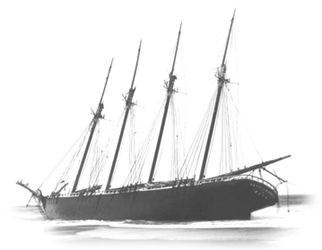
To the mariner, Cape Cod represents both a hazard and a haven, as all shipping between Boston and New York must either pass into its sheltered bay, or ground on its treacherous shoals. Combined with the forces of countless "nor'easters" and its precarious location, the Cape has been the site of more than 3,000 shipwrecks in 300 years of recorded history. The Sparrow-HawkThe first recorded wreck was the Sparrow-Hawk which ran aground at Orleans in 1626. The people aboard were able to get ashore safely, and the ship was repaired. But, before it could set sail, the ship was sunk by another storm and wasn't seen for over two hundred years. In 1863, after storms had shifted the sands again, the skeleton of the Sparrow-Hawk reappeared briefly. So the ocean takes and gives back and takes again. The ribs of the ship are stored in Plymouth at Pilgrim Hall. The WhydahThe Whydah was commissioned in 1715 in London as a slave cargo ship for the Triangular Trade. The ship was named for the slaving port on the coast of West Africa that it planned to operate out of, the "Kingdom of Whydah" (known today as Ouidah). It left England in 1716 on its maiden voyage, landing at port to collect nearly 500 human slaves and other supplies. It then sailed to the Caribbean to exchange the human slaves for precious metals, sugar, indigo, rum, logwood, pimento, ginger, and medicinal ingredients, which were to then be transported back to England. The HMS Somerset (III)The remains of HMS Somerset lie beneath the sands along the outer beach of Provincetown. She was a powerful third-rate line of battle British warship that helped shape the course of American history. With 64 mounted guns and a crew of 400, the Somerset brought British power to the North Atlantic and Mediterranean in the 18th century. By the time the Somerset had wrecked, Cape Codders had suffered greatly from the British blockade during the American Revolution. Commercial fishing and whaling were virtually shut down. Some local people engaged in privateering and smuggling along the coast, while others turned to the land for subsistence. When the giant Somerset wrecked on the Cape, there likely was a strong emotional reaction by the local populace. According to the official account of the ship’s captain, George Ourry, only 21 men were lost during the wreck. Captain Ourry was forced to walk under guard to Providence, RI, where he was exchanged for two American officers. The officers and crew, numbering over 400, were escorted to Boston. Towns along the route provided militia to escort and support the prisoners. A tremendous amount of scarce war material was chopped or pried away from the wreck by Cape Codders before the state put a guard over what remained. Eleven 18-pound and five 9-pound cannon and powder were entrusted to Colonel Paul Revere to be used in fortifying Castle Island in Boston Harbor. Salvage of the Somerset’s cargo was dangerous and difficult. Provisions in the lower hold were only accessible for a few hours a day at low tide. Severe winter storms in December finally broke the remains of the ship apart, moved it closer to shore, and eventually buried it under tons of sand. It took several more months of bitter court proceedings to sort out who owned what in the aftermath of salvage operations. The remains of the Somerset, along with the timbers of thousands of other shipwrecks within the boundary of Cape Cod National Seashore, are preserved as federally protected archeological resources for future generations to research and study. Some shipwrecks have been documented by National Park Service archeologists, but most remain hidden under sand, or offshore. The Somerset is also protected under international law, and is the sovereign property of the United Kingdom. Since 1778, the Somerset’s remains have only surfaced twice: once in the winter of 1885-86, and again in 1973. The National Park Service preserves some of the large timbers from the wreck. The FrancesAt Head of the Meadow Beach at North Truro, the wreck of the Frances, which was sunk in a December gale in 1872, may still be seen at low tide. United States Life Saving Service men dragged a whaleboat from the bay across the Cape to the outer beach and rescued all aboard. The captain, who died several days later from the effects of exposure, is buried in Truro. 
The WhittakerOn the night of November 20, 1872, Captain Cotton in Whittaker, with a cargo of coal, was headed from Hoboken, NJ, to Boston, MA, and went ashore on Hedgefence. The captain got off the next day, having ordered the vessel lightened in which the crew disposed of 20 tons of cargo along with some coal. Within five years, on December 9, 1876, Whittaker “coal laden, for Boston, struck and became a total loss. The crew was saved and entertained…” by Woods End Lighthouse Keeper Thomas Lowe (November 29, 1895, Boston Globe). In fact, Whittaker’s wrecking was so memorable that Lowe used maritime casualty as evidence when advocating for a new lighthouse station on Wood’s End to the United States Lighthouse Establishment. |
Last updated: January 9, 2023
